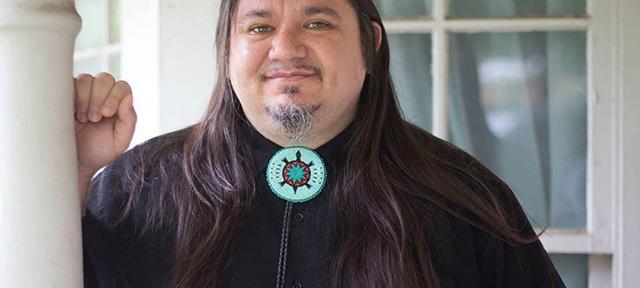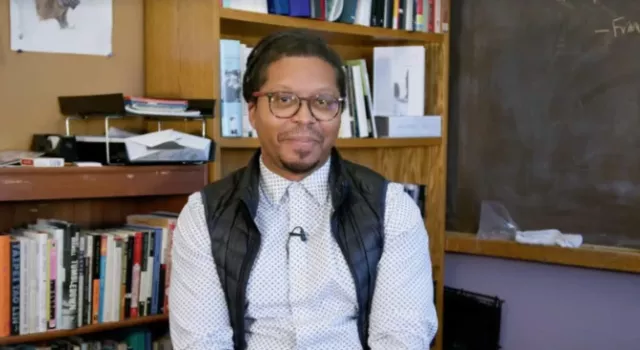Native American and Indigenous Studies Professor Robert Caldwell Brings Deep Research to His Teaching

Professor Robert Caldwell joined the Hampshire community as part of the Five College Consortium’s expansion of the Native American and Indigenous Studies (NAIS) certificate program.
Visiting Professor in Native American and Indigenous Studies Robert Caldwell joined the Hampshire community in the spring of 2021 as part of the Five College Consortium’s expansion of the Native American and Indigenous Studies (NAIS) certificate program. The NAIS program expansion was funded through a recent Mellon Grant, one of the largest made by The Andrew W. Mellon Foundation to the consortium to date, and one of the consortium’s largest grant awards from any funder in its 50-year history.
We sat down (virtually) with Caldwell to learn more about his research in Native communities, foodways, and maps, and what excites him about teaching at Hampshire.
What attracted you to Hampshire?
Since first hearing about Hampshire, the College has always held a certain mystique to me. Hampshire’s exciting curriculum, self-directed concentrations, and focus on student portfolios confirms its reputation for student-centered and collaborative learning. Hampshire’s commitment to social justice and undoing racism was also a draw.
What excites you about teaching at Hampshire and in the NAIS program?
The openness of the Hampshire system helps me learn as well as teach. I consider myself an engaged scholar. My goal of learning and teaching is love, mutual respect, understanding, and transformative justice.
I try to support genuine “bottom-up” organizing whenever and wherever I see it. This has taken many forms over the past twenty years. One example was helping to found the New Orleans Workers’ Center for Racial Justice in the wake of Hurricane Katrina.
The Five College NAIS community and certificate program allow me to be part of a much larger community than at most colleges or universities. That wider network of colleagues and students offers a rich atmosphere conducive to exploration, positive criticism, and support.
What courses are you most excited to teach, and why?
I am overjoyed to have the latitude to design my own courses rather than being constrained by a course catalog. My first course at Hampshire, Indigenous Peoples and Places: How the Lines are Drawn, is an introduction to NAIS from the perspective of maps, spatiality, and territory. In some ways, it is an extension of my dissertation and book manuscript that I hope to complete by the end of this year.
In fall 2021, I will be teaching courses titled Natives as Proletarians: First Nations Peoples as Workers under Capitalism and Black Natives: Anti-Blackness, Indigeneity, and Decolonization. In spring 2022, I plan on teaching Indigenous Organizing and the Struggle for Liberation, 1945–Present, and Not Recognized: Struggle for Indigenous Rights, Land, and Acknowledgement.
How might your research on Native communities in the Southeast be brought into connection with Native communities in New England?
There are many similarities, as well as some important differences, between tribes of the East Coast and Southeast. Obvious connections include foodways, especially the “trinity” of corn, beans, and squash, and sports (lacrosse in the Northeast; Kapucha/Toli/Anejodi, or “stickball,” not to be confused with the street ball game of Northeastern cities, amongst tribes of the Southeast.)
They share experiences based on long histories of colonization, trade, and enmeshment in European conflicts, as well as political similarities and organizations. Tribes with federal acknowledgement belong to USET, the United Southern and Eastern Tribes. Also, among the tribes that were not removed in both New England and Southeast, many continue in their long quest for Federal Recognition.
Why are maps important to thinking about Native American history and culture?
Maps are ubiquitous. We depend on them for navigation, to imagine our place within the world, and to learn about other places. But maps are texts, and, as such, must be read critically. European maps of exploration and early colonization in North America offer a window into the authors’ mentalities, as well as their knowledge of Native people. They often shed important light onto the relationship between Indigenous people and colonizers.
Ethnological maps created primarily by anthropologists in the nineteenth and twentieth centuries to illustrate the original homelands of tribes are often viewed uncritically. A careful look at those maps can tell us as much about anthropological knowledge and conventions of academics who made them as the Native subjects and territories they inscribe.
Your research is focused on contact zones and zones of cultural overlap, or it looks at the negotiation and representation of space that was historically shared by (occupied by or used by) different groups. What lessons can we draw from these histories for the present?
“Contested space” has become a trendy term that has steadily gained influence over the past thirty years, stemming largely from the “spatial turn” in the humanities. The term has immense analytical and explanatory value. The most obvious point of contestation involves power. An often-overlooked aspect of contested terrain has been the miscommunication between Indigenous conceptions of space, symbols, markers, and territoriality and those of European and Euro-Americans.
History (the interpretation of the past) represents contested space. As an historian, I argue that examining the 500-year process of cultural collision and cultural borrowing between Natives, Europeans, and Africans offers U.S.-based students one of the most important lenses for understanding the past, present and considering possibilities for the United States’ future. As a mixed-race Native whose tribe was situated along the dividing line of Imperial Claims (France and Spain, beginning in the early 18th Century) then new Nations (U.S., Mexico after 1821), I have traced the complex interrelations including intertribal intermarriages, negotiations, accommodation, and conflict with settlers, as well as an array of attitudes (including ambivalence, supplication, demands, hostility) toward the colonial state.



